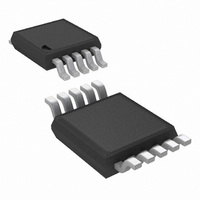LM5020MM-1/NOPB National Semiconductor, LM5020MM-1/NOPB Datasheet - Page 9

LM5020MM-1/NOPB
Manufacturer Part Number
LM5020MM-1/NOPB
Description
IC CONTROLLER PWM 100V 10-MSOP
Manufacturer
National Semiconductor
Series
PowerWise®r
Datasheet
1.LM5020MM-2NOPB.pdf
(13 pages)
Specifications of LM5020MM-1/NOPB
Pwm Type
Current Mode
Number Of Outputs
1
Frequency - Max
1MHz
Duty Cycle
85%
Voltage - Supply
13 V ~ 90 V
Buck
Yes
Boost
Yes
Flyback
Yes
Inverting
Yes
Doubler
No
Divider
No
Cuk
No
Isolated
No
Operating Temperature
-40°C ~ 125°C
Package / Case
10-MSOP, Micro10™, 10-uMAX, 10-uSOP
Frequency-max
1MHz
For Use With
LM5020EVAL - EVALUATION BOARD FOR LM5020
Lead Free Status / RoHS Status
Lead free / RoHS Compliant
Other names
LM5020MM-1
LM5020MM-1TR
LM5020MM-1TR
Available stocks
Company
Part Number
Manufacturer
Quantity
Price
Company:
Part Number:
LM5020MM-1/NOPB
Manufacturer:
TI
Quantity:
15 000
Company:
Part Number:
LM5020MM-1/NOPB
Manufacturer:
NSC
Quantity:
3 000
Part Number:
LM5020MM-1/NOPB
Manufacturer:
NS/国半
Quantity:
20 000
Oscillator and Sync Capability
A single external resistor connected between the RT and
GND pins sets the LM5020 oscillator frequency. Internal to
the LM5020-2 device (50% duty cycle limited option) is an
oscillator divide by two circuit. This divide by two circuit
creates an exact 50% duty cycle pulse which is used inter-
nally to create a precise 50% duty cycle limit function. Be-
cause of this, the internal oscillator actually operates at twice
the frequency of the output (OUT). For the LM5020-1 device
the oscillator frequency and the operational output frequency
are the same. To set a desired output operational frequency
(F), the RT resistor can be calculated from:
LM5020-1:
LM5020-2:
The LM5020 can also be synchronized to an external clock.
The external clock must have a higher frequency than the
free running oscillator frequency set by the RT resistor. The
clock signal should be capacitively coupled into the RT pin
through a 100pF capacitor. A peak voltage level greater than
3.7 Volts at the RT pin is required for detection of the sync
pulse. The sync pulse width should be set between 15 to
150ns by the external components. The RT resistor is al-
ways required, whether the oscillator is free running or ex-
ternally synchronized. The voltage at the RT pin is internally
regulated at 2 Volts. The RT resistor should be located very
close to the device and connected directly to the pins of the
controller (RT and GND).
PWM Comparator / Slope
Compensation
The PWM comparator compares the current ramp signal
with the loop error voltage derived from the error amplifier
output. The error amplifier output voltage at the COMP pin is
offset by 1.4V and then further attenuated by a 3:1 resistor
divider. The PWM comparator polarity is such that 0 Volts on
the COMP pin will result in a zero duty cycle at the controller
output. For duty cycles greater than 50 percent, current
mode control circuits are subject to sub-harmonic oscillation.
By adding an additional fixed slope voltage ramp signal
9
(slope compensation) to the current sense signal, this oscil-
lation can be avoided. The LM5020-1 integrates this slope
compensation by summing a current ramp generated by the
oscillator with the current sense signal. Additional slope
compensation may be added by increasing the source im-
pedance of the current sense signal. Since the LM5020-2 is
not capable of duty cycles greater than 50%, there is no
slope compensation feature in this device.
Soft Start
The softstart feature allows the power converter to gradually
reach the initial steady state operating point, thereby reduc-
ing start-up stresses and current surges. At power on, after
the V
satisfied, an internal 10µA current source charges an exter-
nal capacitor connected to the SS pin. The capacitor voltage
will ramp up slowly and will limit the COMP pin voltage and
the duty cycle of the output pulses.
Gate Driver and Maximum Duty
Cycle Limit
The LM5020 provides an internal gate driver (OUT), which
can source and sink a peak current of 1 Amp. The LM5020 is
available in two duty cycle limit options. The maximum out-
put duty cycle is typically 80% for the LM5020-1 option and
precisely equal to 50% for the LM5020-2 option. The maxi-
mum duty cycle function for the LM5020-2 is accomplished
with an internal toggle flip-flop which ensures an accurate
duty cycle limit. The internal oscillator frequency of the
LM5020-2 is therefore twice the operating frequency of the
PWM controller (OUT pin).
The 80% maximum duty cycle limit of the LM5020-1 is
determined by the internal oscillator and varies more than
the 50% limit of the LM5020-2. For the LM5020-1 the internal
oscillator frequency and the operational frequency of the
PWM controller are equal.
Thermal Protection
Internal thermal shutdown circuitry is provided to protect the
integrated circuit in the event the maximum junction tem-
perature is exceeded. This feature prevents catastrophic
failures from accidental device overheating. When activated,
typically at 165 degrees Celsius, the controller is forced into
a low power standby state, disabling the output driver and
the bias regulator. After the temperature is reduced (typical
hysteresis = 25˚C) the V
start sequence initiated.
CC
and the line undervoltage lockout thresholds are
CC
regulator is enabled and a soft-
www.national.com













